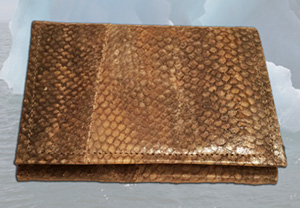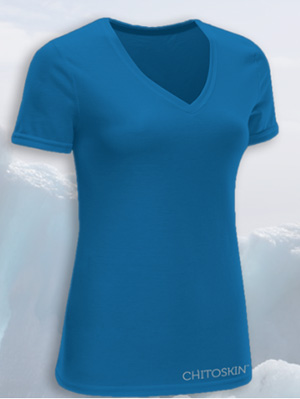|
Fish Factor Southeast Business Launches New Line of Aqua-fabricsBy LAINE WELCH
July 05, 2015
The start-up is making wallets, belts and other products from sheets of salmon skins using an all-natural, proprietary tanning formula from vegetable oils and other eco-friendly ingredients.
“We can produce the same quality and durability products with no formaldehyde, no chrome based tanning chemicals or EPA regulated chemicals to dispose of. And we can do bigger batches with less labor per skins,” said Craig Kasberg, company CEO – that’s Captain Executive Officer. “We’ve come up with a way to remove and dry the skins without any manual labor, and we have a pneumatic heat press that presses the resin into the salmon skins and gives them a consistent durability and glossy finish,” he added. Tidal Vision launched its aquatic leather line on Kickstarter, a web based ‘crowd funding’ community that has helped bring nearly 90,000 creative ideas to life since 2009. The company reached its $17,500 funding goal in less than 24 hours and now has 764 backers who have pledged $55,664 to the project. (Only 14% of the business hopefuls raise $20,000 or more through their whole campaign, according to Kickstarter’s website.) Now Tidal Vision aims to attract business partners to grow the small company. Coming this fall is a line of clothing and textiles made from a polymer in crab and shrimp shells called chitin, whose applications range from commercial water filtration to textile and pharmaceutical uses, such as dissolvable sutures. After it is extracted, Chitin has not been able to be produced in the US because of the harsh chemicals used. For about 40 years it has been made in China and India because those countries have less stringent regulations on disposal. “Our chemist, who has a Ph. D.in “chitonous biomass” from the University of Alabama has derived a much simpler solution that has turned chitin production on its head,” Kasberg said.” “We use one mixture that contains no hydrochloric acid or sodium hydroxide. It’s an ionic solution extraction that dislodges the chitin from everything else in the shells and disperses itself into a fluid. From there it goes through a series of pumps and filters in a closed loop system so all of the fluid is recycled and can be used repeatedly.” Another plus: the system is being designed for use in mobile shipping containers, so the units can be sent to remote locations and the valuable products returned for production elsewhere. In fabrics, chitin acts as a natural antibacterial, antimicrobial polymer that kills odors from sweat. Other textile and apparel companies use chitin as a coating that tends to wash out and wear off over time. The proprietary Tidal Vision process extrudes the chitin molecules into a fiber, which is then spun into yarn or blended, and used to knit the textiles into apparel products. “The process of spinning the fibers into the yarn makes chitosan a structural component of the fabrics so the odor fighting properties last longer,” Kasberg said. Yet another plus: crab from Alaska contain a higher percentage of chitin than species found elsewhere. “We’ve tested brown king crab from Southeast Alaska, Tanners, Dungeness and blue crab and shrimp from all over the country. The Alaska crabs can yield up to two times as much chitin from their shells,” Kasberg said. Tidal Vision will launch its line of Chitoskin aqua-fabrics this fall. Visit TidalVisionUSA.com and see/order its line of salmon skin products at www.kickstarter.com. Tracking the movement and growth of young halibut is the focus of a new project underway since May in the Gulf of Alaska and the Bering Sea. “Although we have done a lot of tagging over the years we haven't done much with the smallest category of juveniles that we encounter,” said Bruce Leaman, executive director of the International Pacific Halibut Commission. “And by the smallest I mean the 15 to 45 centimeter range (about four pounds), which is what a lot of the juveniles in the Eastern Bering Sea are.” Part of understanding and solving the bycatch issue is knowing much more about what the distribution and movement rates of the juveniles are, Leaman explained. The tagging is being done during the annual summer trawl surveys used for overall halibut stock assessments. IPHC researchers have a standard set of survey “stations” that are widely spaced so fish will be able to be tagged in many different locations. About 1,000 toddler halibut have been tagged in the Gulf, and 800 in the Bering Sea. Researchers hope to tag 2,000 fish by August. “We are trying to figure out if we can tag these things with any kind of facility, what kind of condition they are in, and whether or not it’s worthwhile for us to try and think about doing this on a much bigger scale,” Leaman said. Fishermen catching a tagged halibut should notify the IPHC in Seattle and report the information on the tag. Better yet, bring the tagged fish to IPHC port samplers stationed from Dutch Harbor to Petersburg so they can sample it. Icicle Seafoods has been sold to Convergence Holdings, Inc. and Dominion Catchers LLC of Indonesia. Paine & Partners, a global private equity agribusiness firm announced the sale in late June and hopes to have the deal completed in August. Along with a fleet of 11 vessels, Icicle owns shore plants in Petersburg, Seward, Egegik at Bristol Bay, Larsen Bay at Kodiak and near Dillingham. Terms of the sale were not disclosed. North Pacific Seafoods has reached an agreement with Inlet Fish Producers, Inc. to buy their Kenai and Kasilof processing facilities. North Pacific is owned by Marubeni, one of Japan’s largest seafood trading houses, which paid an estimated $8 million for the company. North Pacific’s John Garner said that no personnel changes are expected as a result of the purchase. With the Inlet acquisition, North Pacific expands its processing presence in Alaska to seven facilities-- three in Bristol Bay, one each in Kodiak and Sitka, and two on the Kenai Peninsula. Russia has extended its ban on food imports from the US, the European Union, Canada, Australia and Norway for another year. For Alaska, that adds up to a loss of $60 million and 20 million pounds of seafood sales, mostly pink salmon roe and pollock surimi. The food ban resulted from trade sanctions imposed on Russia by the US and several other nations due to its aggressive actions in the Ukraine.
Laine Welch ©2015 www.alaskafishradio.com SitNews ©2015 Stories In The News Ketchikan, Alaska
|
|||


